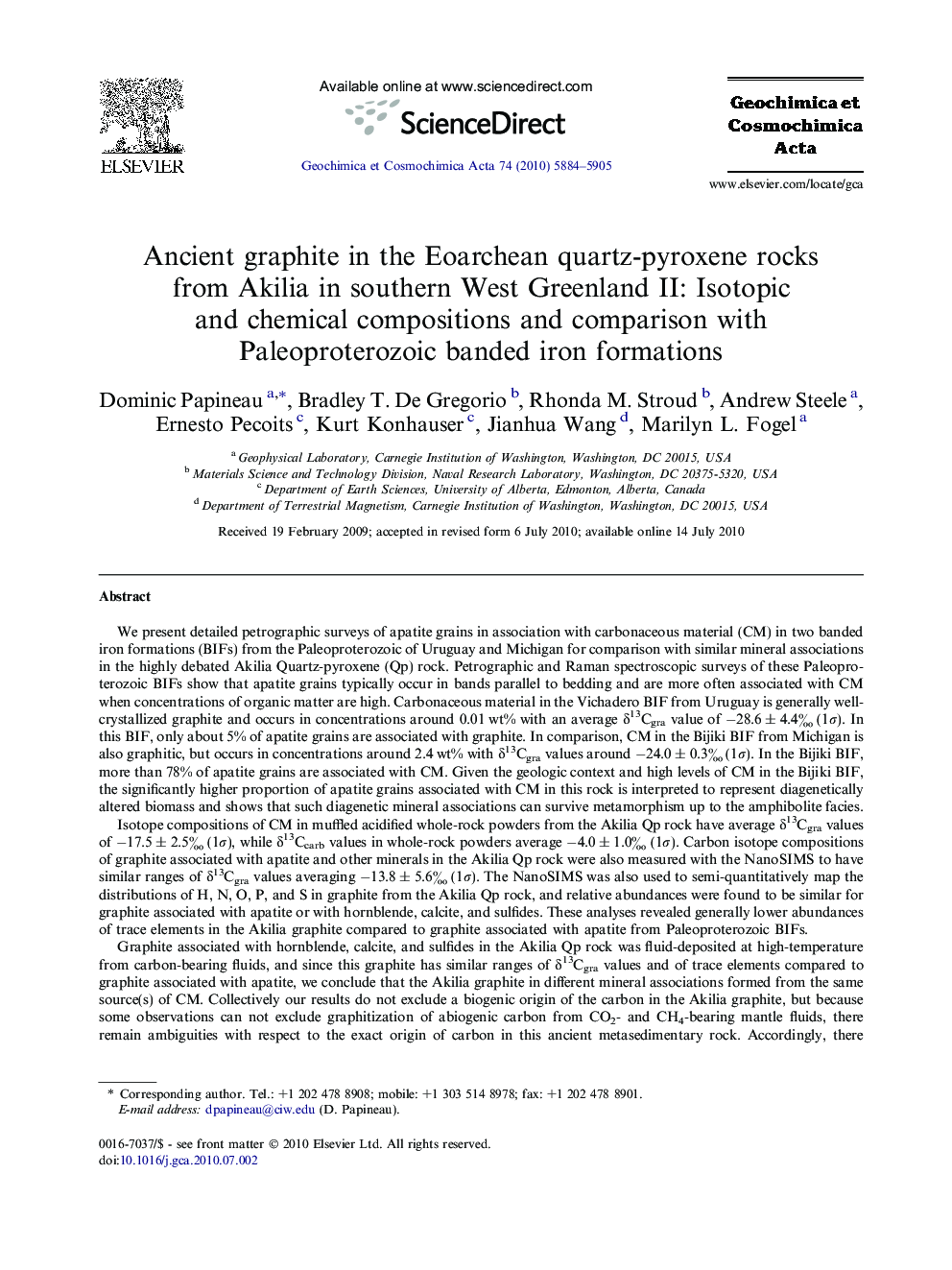| کد مقاله | کد نشریه | سال انتشار | مقاله انگلیسی | نسخه تمام متن |
|---|---|---|---|---|
| 4703807 | 1352881 | 2010 | 22 صفحه PDF | دانلود رایگان |

We present detailed petrographic surveys of apatite grains in association with carbonaceous material (CM) in two banded iron formations (BIFs) from the Paleoproterozoic of Uruguay and Michigan for comparison with similar mineral associations in the highly debated Akilia Quartz-pyroxene (Qp) rock. Petrographic and Raman spectroscopic surveys of these Paleoproterozoic BIFs show that apatite grains typically occur in bands parallel to bedding and are more often associated with CM when concentrations of organic matter are high. Carbonaceous material in the Vichadero BIF from Uruguay is generally well-crystallized graphite and occurs in concentrations around 0.01 wt% with an average δ13Cgra value of −28.6 ± 4.4‰ (1σ). In this BIF, only about 5% of apatite grains are associated with graphite. In comparison, CM in the Bijiki BIF from Michigan is also graphitic, but occurs in concentrations around 2.4 wt% with δ13Cgra values around −24.0 ± 0.3‰ (1σ). In the Bijiki BIF, more than 78% of apatite grains are associated with CM. Given the geologic context and high levels of CM in the Bijiki BIF, the significantly higher proportion of apatite grains associated with CM in this rock is interpreted to represent diagenetically altered biomass and shows that such diagenetic mineral associations can survive metamorphism up to the amphibolite facies.Isotope compositions of CM in muffled acidified whole-rock powders from the Akilia Qp rock have average δ13Cgra values of −17.5 ± 2.5‰ (1σ), while δ13Ccarb values in whole-rock powders average −4.0 ± 1.0‰ (1σ). Carbon isotope compositions of graphite associated with apatite and other minerals in the Akilia Qp rock were also measured with the NanoSIMS to have similar ranges of δ13Cgra values averaging −13.8 ± 5.6‰ (1σ). The NanoSIMS was also used to semi-quantitatively map the distributions of H, N, O, P, and S in graphite from the Akilia Qp rock, and relative abundances were found to be similar for graphite associated with apatite or with hornblende, calcite, and sulfides. These analyses revealed generally lower abundances of trace elements in the Akilia graphite compared to graphite associated with apatite from Paleoproterozoic BIFs.Graphite associated with hornblende, calcite, and sulfides in the Akilia Qp rock was fluid-deposited at high-temperature from carbon-bearing fluids, and since this graphite has similar ranges of δ13Cgra values and of trace elements compared to graphite associated with apatite, we conclude that the Akilia graphite in different mineral associations formed from the same source(s) of CM. Collectively our results do not exclude a biogenic origin of the carbon in the Akilia graphite, but because some observations can not exclude graphitization of abiogenic carbon from CO2- and CH4-bearing mantle fluids, there remain ambiguities with respect to the exact origin of carbon in this ancient metasedimentary rock. Accordingly, there may have been several generations of graphite formation along with possibly varying mixtures of CO2- and CH4-bearing fluids that may have resulted in large ranges of δ13Cgra values. The possibility of fluid-deposited graphite associated with apatite should be a focus of future investigations as this may prove to be an alternative pathway of graphitization from phosphate-bearing fluids. Correlated micro-analytical approaches tested on terrestrial rocks in this work provide insights into the origin of carbon in ancient graphite and will pave the way for the search for life on other ancient planetary surfaces.
Journal: Geochimica et Cosmochimica Acta - Volume 74, Issue 20, 15 October 2010, Pages 5884–5905